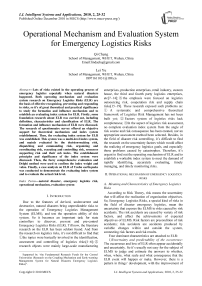Operational Mechanism and Evaluation System for Emergency Logistics Risks
Автор: Qi Cheng, Lei Yu
Журнал: International Journal of Intelligent Systems and Applications(IJISA) @ijisa
Статья в выпуске: 2 vol.2, 2010 года.
Бесплатный доступ
Lots of risks existed in the operating process of emergency logistics especially when natural disasters happened. Both operating mechanism and evaluation system research on Emergency Logistics Risks (ELR) are the basis of effective recognizing, preventing and responding to risks, so it’s of great theoretical and practical significance to study the formation and influence mechanism and to establish an evaluating index system for ELR. Firstly, some foundation research about ELR was carried out, including definition, characteristics and classification of ELR. The formation and influence mechanism of ELR were discussed. The research of questionnaire survey offered an objective support for theoretical mechanism and index system establishment. Then, the evaluating index system for ELR was established. This system was a multi-level index system, and mainly evaluated by the decision-making risk, dispatching and commanding risk, organizing and coordinating risk, executing and controlling risk, resources supporting risk and their sub index. The establishment principles and significance of the index system were discussed. Then, the fuzzy comprehensive evaluation and Delphi method were used to confirm the index weight and value. Finally, a case analysis on ELR of Yushu earthquake was conducted to demonstrate the evaluating index system and to evaluate the actual risk level.
Natural disaster, emergency logistics risk, operational mechanism, evaluation system
Короткий адрес: https://sciup.org/15010144
IDR: 15010144
Текст научной статьи Operational Mechanism and Evaluation System for Emergency Logistics Risks
Published Online December 2010 in MECS
Due to the features of derived, undercurrent and destructive, natural disasters bring unpredictable risks to the operation of Emergency Logistics Management System (ELMS), and test the operation ability of this system. So it becomes an important task for state controllers to discover, prevent and pre-control Emergency Logistics Risks (ELR). Till now, the literature research on the ELR has been seldom found. And from the research on logistics risks, it’s not difficult to find that: ® the topics were basically involved in the identification, assessment and controlling of logistics risks[1~6]; ® research objects were mainly large-scale manufacturing
Supported by “the Fundamental Research Funds for the Central Universities (Research on the Coupling Mechanism and Early-warning Management System for Natural Disasters Emergency Logistics Risks)”.
enterprises, production enterprises, retail industry, custom house, the third and fourth party logistics enterprises, etc[7~14]; @ the emphasis were focused on logistics outsourcing risk, cooperation risk and supply chain risks[15~19]. These research exposed such problems as: ® A systematic and comprehensive theoretical framework of Logistics Risk Management has not been built yet; ® Factors system of logistics risks lack completeness; ® In the aspect of logistics risk assessment, no complete evaluation index system from the angle of risk source and risk consequence has been created, nor an appropriate assessment method been selected. Besides, in the field of disaster risk controlling, it’s difficult to find the research on the uncertainty factors which would affect the realizing of emergency logistics goals, and especially those problems caused by catastrophes. Therefore, it’s urgent to find out the operating mechanism of ELR and to establish a workable index system to meet the demand of rapidly identifying, accurately evaluating, timely managing, and timely monitoring risks.
-
II. Operational mechanism of emergency logistics
RISKS
-
A. Meaning and Characteristics of Emergency Logistics Risks
According to Risk Theory, risk means the uncertainty that will affect the realization of organization objectives. So, Emergency Logistics Risks, a special kind of risks in the field of disaster emergency logistics, mean the uncertainty that exposes the ELMS to risks caused by risk accidents. The risk accidents are caused by variety of risk factors, and affect the achievements of expected objectives of ELMS. Risk factors are precondition of risk accidents; risk accidents are accidents produced by variable changes within and outside the system, connecting risk factors and risk results.
Four dominant characteristics are attached to ELR:
1)Uncertainty and predictability of the occurrence: The occurrence and loss of ELR often appear accidentally and uncertainly. So it’s usually not easy for the subject of ELMS to judge and estimate the answers to whether, when, where, what scale and what consequence that the ELR event will happen or make. However, there is a pattern in things’ development, with the improvement of people’s technology and knowledge, the pattern of ELR can be mastered, too. With some advanced techniques and more knowledge or data, the frequency and scope of ELR will be predicted to some extent.
2)Timeliness and variability of the occurrence and existence: ELR usually happened all of a sudden, difficult to identify and kept a rapid pace of change, so we demand a real-time monitoring, a high speed responding and a perfect accuracy of disposing. ELR’s variability is reflected in both quality and quantity, the decrease in extent of losses caused by the risk is quantitative, while the new risk caused by the old ones is qualitative.
3)Elusiveness and correlation of the existence: Some kinds of ELR are very secluded and difficult to identify, while some kinds occur and develop by leaps and bounds with a short life cycle. Then, it’s very difficult to control the risk once noticed. On the other hand, in the emergency state of disaster, with a complex and ambiguous relationship, the ELR may exist in one or several levels and links of the Emergency Logistics.
4)Controllability of the factors: Risk factors’ accumulation and certain conditions are needed in ELR’s occurrence. If the accumulation and necessary conditions can be controlled, the risks’ occurrence will be stopped. If some measures can be taken to change the conditions of risks’ occurrence, the risks may be resolved by transformation, even be defused.
-
B. Causes and Categories of Emergency Logistics Risks
A few researches were found about the classification, but Zhou Yu [20] thought that ELR consisted of emergency materials risk, emergency logistics (EL) institution risk, EL transport system risk and EL information risk; Zhao Yong [21] held the view that ELR was made up of technical risk, environment risk, management risk and operation risk.
To reveal the logical relations of factors that causing ELR, this paper firstly divided the ELR into five types, namely, decision-making risk, dispatching and commanding risk, organizing and coordinating risk, executing and controlling risk, resources supporting risk. Besides, according to the value chain theory, the process of emergency logistics can be regarded as the value added process of emergency rescuing supplies, including time efficiency, space efficiency, staff efficiency and supply efficiency are added to the rescuing supplies, in which the supply efficiency is made up of rescuing supplies efficiency and equipment efficiency. ELR will affect the play of these efficiencies. The categories of ELR and their contributing factors, as well as the aspects in which ELR will affect the supply value are summarized in table
Among them:
-
1) Decision-making risk: is the possibility of the defective early-warning system or the decision-makers’ lack of quality and management skills that will lead to decision-making errors. Decision-makers risk, specific plans lacking risk, experts selecting risk and early-warning system risk contribute to decision-making risk, which will affect the entire process through the effects on time efficiency, space efficiency, staff efficiency and
supply efficiency. As a result, measures should be taken to overcome it at first.
-
2) Dispatching and commanding risk : is the possibility of the defective management system, scattered distribution of areas and the lack of resources that will lead to the low efficiency of Emergency Logistics. Victims’ distribution risk, emergency transport capacity risk, scheduling risk and commanding risk contribute to dispatching and commanding risk, which is an important factor that has effects on the time efficiency, space efficiency and staff efficiency.
TABLE I.
C ategories and causes of E mergency L ogistics R isks
|
Categories |
Causes |
Value effects |
|
Decision-making risk |
Decision-makers risk, specific plans lacking risk, experts selecting risk, early-warning system risk |
Time efficiency Space efficiency Staff efficiency Supply efficiency |
|
Dispatching & commanding risk |
Victims’ distribution risk, emergency transport capacity risk, scheduling risk, commanding risk |
Time efficiency Space efficiency Staff efficiency |
|
Organizing & coordinating risk |
Administration risk, military-local cooperation risk, regional support risk, national mobilization risk |
Staff efficiency |
|
Executing & controlling risk |
Personnel status risk, personnel behaviors risk, personnel ability risk |
Time efficiency Supply efficiency |
|
Resources supporting risk |
Environment influence and threat, availability of transportation network |
Supply efficiency |
|
Supplies risk, conveyance risk, funds risk, communication risk, etc. |
-
3) Organizing and coordinating risk : is the possibility of divergences in cooperation. Administration risk, military-local cooperation risk, regional support risk and national mobilization risk contribute to organizing and coordinating risk, which is the key factor that affects staff efficiency.
-
4) Executing and controlling risk : is the possibility of the instruction’s executing error, processes’ controlling failure and staff’s bad state or behaviors that lead to the difference between the plan and result. Personnel status risk, personnel behaviors risk and personnel ability risk contribute to executing and controlling risk, which is a main factor that affects supply efficiency and time efficiency.
-
5) Resources supporting risk : is the possibility of the secondary disaster and environment damage caused by the disasters that result in the damage of logistics facilities, equipment and supplies. Resources supporting risk can be divided into two parts which affect the supply efficiency. Environment influence and threat as well as risk of transportation network availability contribute to one part, while emergency supplies risk, conveyance risk, emergency funds risk, communication and information risk contribute to the other part.
C.Influence Mechanism of Emergency Logistics Risks
Decision-making risk is the primary factor of ELR that has effects on the entire emergency logistics process. Take the procurement delays for example, the decision- makers’ error in the judgment of purchasing time may not only lead to the effects on timeliness of getting supplies caused by the decline of time efficiency, but also result in some additional work to make up the loss caused by time delays. Similarly, decision-making risk may also lead to some other risk events such as lack of distribution, lack of specific plans and unreasonable distribution of nodes, which then result in the consequences including the supplies’ arrival delays, quantity lacks and category errors.
Dispatching and commanding risk affects all aspects of emergency logistics through the staff dispatching errors, transportation and distribution delays, then logistic works fall into chaos with low efficiency. Take the staff dispatching errors for example, once the overworked staff is still arranged to work overtime in the front line, the science and rationality of instructions or dispatching and commanding plans are sure to be affected, even some commanding mistakes would be made, leading to serious effects on emergency logistics’ effectiveness, efficiency and normal operation. Similarly, the traffic block caused by dispatching and commanding risk may also lead to supplies’ arrival delays, etc.
Organizing and coordinating risk affects the time efficiency of emergency logistics by reducing the efficiency of human resources. Disaster emergency logistics are teamwork with several subjects, including fire officers, medical teams, logistics companies and volunteers. Once organizing and coordinating risks break out, subjects’ works will be restricted by each other, affecting not only the whole effectiveness, but also the independent work, leading to the result that the corporate effectiveness is than the sum of independent ones. In the case of fire officers and logistics companies’ cooperation, fire officers are responsible for repairing the broken transportation, while the logistics companies transport the related supplies for supporting. Once an organizing and coordinating error comes out, logistics companies’ transportation delays will lead to the lag of fire officers’ repairing works, which affect other transportations in return, causing disorders.
Executing and controlling risk’s outbreak will not only affect EL’s normal operation, but also lead emergency logistics to get out of the planning track, resulting in more risk accidents. For example, in the procurement chaos after disasters, lax execution and control would lead to the accidents of procuring staff’s shoddy or supply lacks, resulting in the consequence that the supplies cannot meet victims’ requirements.
Influence mechanism of the risks can be demonstrated as Fig. 1:
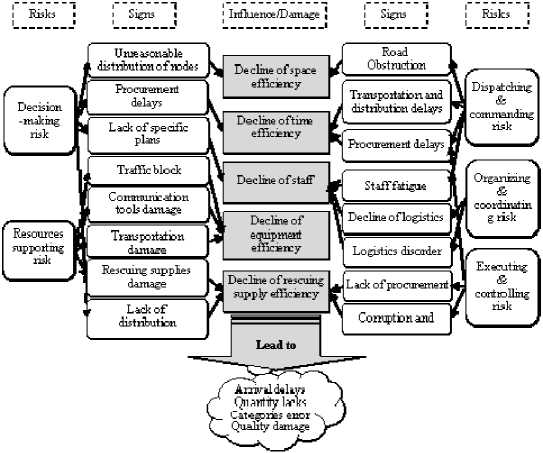
Figure1. Influence mechanism Emergency Logistics Risks
D.Questionnaire Survey
In order to further understand the operational mechanism of ELR and to identify key risk factors, and to better prevent ELR, Methods An anonymous questionnaire was conducted among 120 scholars home and abroad in the logistics field which resulted in 75.0%(90) sample return and an effective rate of 96.7%(87).
-
1) Possibility and severity of Emergency logistics risks: Equation (1) indicates the connotation of risk. According to this equation and using the Likert Scale (each item adopted the 5-degree scoring), we chose 26 possible risk events, and invited the respondents to give their judgments. Respondents scored for the possibility of risk events (as Fig. 2~7) and the severity of events consequence (as Fig.8).
Risk = probability of event * event consequence 1)
Unreasonable dispatching and command lead to Staff fatigue
Transportation’s breakdown leads to rescuing supplies damage
Transportation’s breakdown leads to procurement delays
Lax execution and control lead to Lack of procurement
Lax execution and control lead to procurement delays
Logistics disorder Unreasonable dispatching and command lead to procurement delays
Decision-making errors lead to Lack of special plans
Unreasonable dispatching and command lead to road obstruction
Transportation channel’s destroys and obstructions lead to procurement delays
Communication tools’ breakdown leads to errors of information transmission
Lax execution and control lead to corruption and misappropriation Decision-making errors lead to Lack of distribution
Decision-making errors lead to unreasonable distribution of nodes
Decision-making errors lead to procurement delays
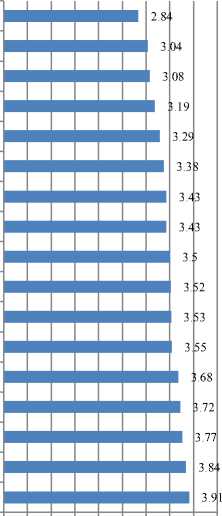
0 0.5 1 1.5 2 2.5 3 3.5 4 4.5
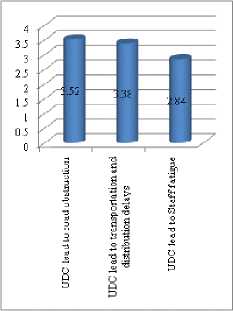
Notes: UDC, abbreviation for unreasonable dispatching and command
Figure 2. Possibility of emergency logistics risk events
Notes: DMC, decision
Figure 3.
decision-
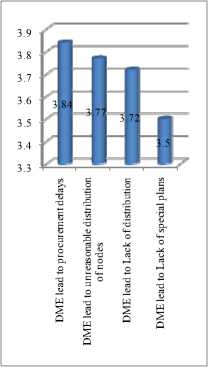
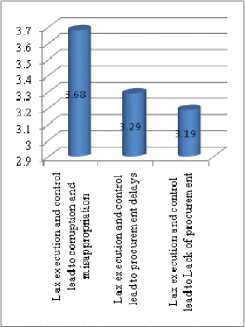
abbreviation for making errors
Possibility of making risk
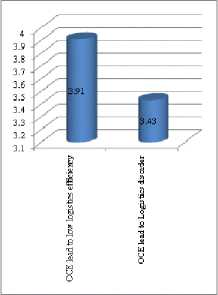
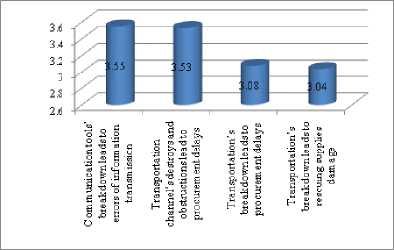
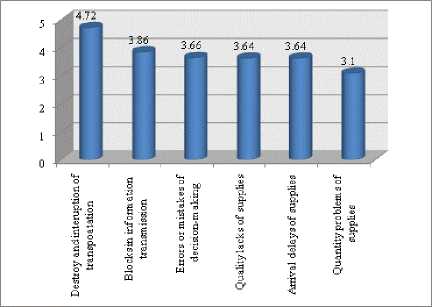
Figure 8. Severity of typical risk consequences
It’s easy to find out:
Finally, less possible though the accidents of EL efficiency’s decline caused by the destroy of transportation channels and communication tools are regarded, due to the serious consequence they would lead to, this two risk accidents should be prevented strictly, too.
-
2) Key factors of Emergency Logistics Risks : Risk factors were summarized into 26 ones in the questionnaire, respondents scored for the key degree of each one (The scores were converted into hundred mark system in the statistics). Results show that the degree of transportation’s damage and disruption, reliability of EL dispatching and commanding, rationality of rescuing repositories’ distribution and timeliness of government’s Emergency response are the most key factors; a complete and reliable EL specific plan, the disaster’s complexity, size of disaster area, quantity of victims, the participation of military logistics force and special EL management agencies are followed. The convey results are shown in table 2 below:
TABLE II.
KEY DEGREE OF RISK FACTORS
|
Risk factors |
Key degree |
|
|
1) |
Degree of transportation’s damage and disruption |
96.6 |
|
2) |
Reliability of EL dispatching and commanding |
94.8 |
|
3) |
Rationality of rescuing repositories’ distribution |
93.1 |
|
4) |
Timeliness of government’s Emergency response |
93.1 |
|
5) |
A complete and reliable EL specific plan |
91.4 |
|
6) |
Participation of military logistics force |
89.7 |
|
7) |
Size of disaster area |
89.7 |
|
8) |
The disaster’s complexity |
89.7 |
|
9) |
Quantity of victims |
87.9 |
|
10) |
Special EL management agencies |
87.9 |
|
11) |
Rationality of EL center’s location and function |
86.2 |
|
12) |
Completeness of EL laws and regulations |
86.2 |
|
13) |
The disaster’s destruction |
86.2 |
|
14) |
Shortage of emergency supplies |
86.2 |
|
15) |
Reliability(accuracy, openness and timeliness) of materials’ supply and demand information |
86.2 |
|
16) |
Rationality of transport choice |
86.2 |
|
17) |
Reliability of rescuing supplies provider |
84.5 |
|
18) |
Effects of Logistics industry organizations |
84.5 |
|
19) The normal operation of logistic equipment |
84.5 |
|
20) Physical state of the relevant staff |
84.5 |
|
21) Effects of secondary disaster’s destruction |
84.4 |
|
22) Authority of government emergency response agency |
84.4 |
|
23) Reliability of community donations |
75.8 |
|
24) Choice of experts |
75.6 |
|
25) Insurance products established specially for EL |
74.1 |
|
26) Participation of social logistic enterprise |
73.2 |
Ш . CONSTRUCTION OF EVALUATING INDEX SYSTEM
A.Construction Significance of Evaluating Index System
Risks are potential threats to ELMS, testing ELMS’s operational capabilities. So, it’s necessary to monitor, identify, analyze, and control risk factors before risk accumulation degree would badly affect ELMS. The establishment of evaluating index system for ELR could acquaint state controllers with potential risks, and confirm doable approaches to decrease risk rate according to actual index value. All these efforts aim to help ELMS run and develop in a safer and steadier way.
B.Construction Principles of Evaluating Index System
The evaluation on ELR is to identify an individual or several key factors of ELR on the information collected, thus to provide a scientific decision and management basis, and to meet the emergency supplies’ demand of disaster-stricken areas in the shortest time. Therefore, in the evaluation process, the following principles should be paid attention to:
1)Scientific and objective: The assessment should be consistent with objective reality, which can reflect the degree of ELR wholly and truly, and can ensure results accurate.
2)Comprehensive and representative: All the key factors constituting ELR and thire relationship should be considered. The index should be concise, representative, without missing.
3)Practicable and Measurable: The system should have a clear logic, distinct levels to make sure that the evaluation value can be acquired accurately and quickly, and each indicator in the system is applicative to quantitative analysis.
4)Relevant and dynamic: A variety of internal relations in the practical management work should be reflected, as well as the risks’ dynamic characteristic.
C.Framework of Evaluation Index System
Based on above formation research on ELR and establishing principles, the framework of evaluating index system for ELR could be confirmed by the method of Delphi (see Tab. 2). Considering risk probability and loss represented by various indicators, the method of Priority Sequence Table was used to screen indicators, and finally, the evaluating index system was confirm, as table 2 describes, including target layer, factor layer and index layer, a total of 23 indexes.
TABLE III.
FRAMEWORK OF EVALUATING INDEX SYSTEM
|
Target layer |
Factor layer |
Index layer |
|
Evaluating Index System Of ELR R |
Decisionmaking risk R 1 |
Decision-makers’ poor experience and limited ability R 11 |
|
Lack of specific emergency logistics plans R 12 |
||
|
Experts with poor authoritative influence R 13 |
||
|
Forewarning Information lacking high accuracy R 14 |
||
|
Dispatching and commanding risk R 2 |
Scattered distribution of disaster areaR 21 |
|
|
Lack of emergency transport capacityR 22 |
||
|
Unscientific scheduling schemes R 23 |
||
|
Improper scheduling arrangements R 24 |
||
|
Multiple-headed commanding R 25 |
||
|
Organizing and coordinating risk R 3 |
Unreasonably established administration R 31 |
|
|
Poor communication between military and civilian R 32 |
||
|
Difficulties in cross-regional deployment R 33 |
||
|
Inadequate national mobilization R 34 |
||
|
Executing and controlling risk R 4 |
Command to lose efficacy R 41 |
|
|
Slow action R 42 |
||
|
Fatigue operation R 43 |
||
|
Irregular operation R 44 |
||
|
Resources supporting risk R 5 |
Continuous secondary disasters and bad weather R 51 |
|
|
Insufficient means of transport R 52 |
||
|
Damaged degree of transport channel R 53 |
||
|
Shortage of emergency funds and materialsR 54 |
||
|
Breakdown of communication & information networks R 55 |
||
|
Lack of specific information platform for EL R 56 |
D. Evaluation Mode
According to the index system framework of ELR for natural disasters, using the method of Synthesizing Evaluation of Multiple Indexes, evaluation model for ELR was established as follows:
m
R = ^R i * W i (1)
i=i
n
R i = ^R ij *W ij (2)
i=i
Among them, R represents the value of target layer indicator in this index system, used to indicate the overall risk of ELMS, the bigger the value is, indicating that the higher the risk level is. R i (i=1, …,5) respectively are evaluation value indicating the indicators on factor layer, R i j (i=1, …,5; j=4,5,or 6) represent evaluation value of indicators on index layer. W i and W ij respectively express the weight in each corresponding layer. Detailed evaluation method sees FCE below.
E. Evaluation Method: Fuzzy Comprehensive Evaluation
Fuzzy Comprehensive Evaluation (FCE) is a fuzzy mathematics-based comprehensive evaluation method, in which synthetic fuzzy relations theory is used to quantify various factors. By building a fuzzy class, it will quantify indicators that reflect the fuzzy evaluated matter. It’s a combination of qualitative and quantitative evaluation method [22]. Analytical Hierarchy Process (AHP) is also a combination of qualitative and quantitative analysis method for decision-making. It decomposes a complex problem into a number of levels and factors, and then calculates weight for different program after comparison among various factors. In FCE, AHP is mainly used to determine the weights of various influencing factors. In this paper, FCE method was used to evaluate the evaluating index system of ELR, so as to achieve the early-warning and forecasting of the potential risk.
Steps of FCE are as follows:
-
1) Confirm the factor set R. T he multifactor FCE model of ELRAIS was set up as Tab.2. According to Tab.2, the factor set is expressed to 2 layers: the target level R= {R 1 , R 2, R 3, R 4, R 5, }; the factor level R 1 = {R 11 , R 12 , R 13 , R 14 }; R 2 = {R 21 , R 22 , R 23 , R 24, R 25 }; … R 5 = {R 51 , R 52 , R 53, R 54, R 55 , R 56 }.
-
2) Confirm the appraisal set V and assign its U. The evaluating set is a set of different evaluation results. According to the probability of risk occurring, ELR can be divided into different risk grades. This paper utilizes an evaluation of 5grades, see Tab.3. V= (V 1 , V 2 , V 3 , V 4 , V 5 ) = (Extremely risk, rather risk, middle risk, light risk, almost not risk). Differentiates score about grades are: U= (U 1 , U 2 , U 3 , U 4 , U 5 ) = (100, 80, 60, 40, 20).
TABLE IV.
GRADES OF EMERGENCY LOGISTICS RISKS
|
Risk grade V |
Value range U |
Description of the probability of risk occurrence |
|
Extremely riskV 1 |
80~100 |
Extremely probably occur |
|
Rather riskV 2 |
60~80 |
Probably occur |
|
Middle riskV 3 |
40~60 |
May occur |
|
Light riskV 4 |
20~40 |
Might occur |
|
Almost not riskV 5 |
0~20 |
Almost will not occur |
-
3) Confirm the weight set W of evaluating index. Weight is the important yardstick to reflect influence degree of every evaluating index. The paper adopted AHP to fix the weight. To give each indicator different weights, and the fuzzy weight set of each indicator is:
W=(W 1 ,W 2 ,W 3 ,W 4 ,W 5 );W i =(W i1 ,…,W ij ),{(i,j)=(1,4),(2 ,5),(3,4),(4,4),(5,6)};
And, 1^ = 1, Z ] n =i ^ ii = 1.
-
4) Confirm the evaluation matrix R. In this research, the matrix is a two –layer model, the first layer R, the second layer R i . According to the grades of logistics risks V in Table3, experts will mark R il for different risks from V 1 to V 5, combined with the actual investigating result of the practice, which make up the single factor appraisal matrix R i, namely:
R i11
R i21
R i12 R i13
R i22 R i23
R i14 R i15
R i24 R i25
R i =
R in1
R in2 R in3
R in4 R in5
-
5) Analyze a single element: the subset R i of element set R could be denoted by fuzzy vector U i = {V i1 , V i2 , V i3 , …, V in }. For the given Ri, U i , the single element
evaluating vector could be drawn, i.e. B i =R i •U i . The same method, Rwill be made up.
-
6) Evaluate comprehensively. The factor level R i can be denoted by fuzzy vector W ij and R ij , R i =W i ∙R i = (W i1 ,…,W in ) ∙(R il , R i2 ,…, R in ) T , i=1,2,3,4,5; n=1,2,3,4 or n=1,2,3,4,5 or n=1,2,3,4,5,6. Then, the comprehensive appraisal value of R can be calculated by R= W^B = ( W 1 , W 2 , W 3 , W 4 , W 5 ) • (R 1 , R 2 , R 3 , R 4 , R 5 )t. According to the section which the result on fuzzy comprehensive evaluation R locates in (table 3), the risk level of ELR is confirmed.
F. Case Analysis
1) Basic Information about Yushu Earthquake and the Emergency Logistics for it
A 7.1-magnitude earthquake attacked Yushu County, Qinghai Province on April 14, 2010. Up to April 20, 2046 people had been killed by the earthquake and 12,135 people were injured [23]. There were a lot of heavy difficulties to carry out emergency logistics for Yushu earthquake, because it was the largest scale of earthquake relief so far in the plateau region above the altitude of 4,000 meters. This emergency logistics was by only a fragile transport route, away from city supports, and lack of rescue forces, equipments and materials.
2) Evaluation of ELR for Yushu Earthquake
-
a. Confirm the appraisal set and evaluation matrix:According to the actual ELR condition for Yushu Earthquake, 7 experts in China were invited to judge the grade of each index of each level. Take the indicator ‘Resources supporting risk R5’ as an example, Tab. 4 is the value range of this indicator. Each expert marked each term according to actual control level and integrated their results. The integration is R5.
R 5 =
0.6 0.3 0.1 0 0 0.4 0.4 0.1 0.1 0 0.5 0.3 0.2 0 0 0.2 0.2 0.3 0.2 0.1 0.3 0.3 0.2 0.1 0.1 0.2 0.4 0.2 0.2 0
So, B 5 =R 5 •U= (90, 82, 90, 64, 72, 72) T .
b.Confirm the weight: The rational index weight would reflect the significance of the risks indicated by each warning index. According to the actual conditions and the experts’ suggestions, AHP was used to confirm the weight of each index.
W=(0.20,0.21,0.18,0.14,0.27);
W1=(0.35,0.30,0.10,0.25);
W2=(0.15,0.25,0.30,0.20,0.10);
W3=(0.20,0.25,0.20,0.35).
W4=(0.40,0.30,0.15,0.15);
W5= (0.25,0.20,0.15,0.10,0.15,0.15).
c.Evaluation of the single factor R5:According to the algorithm, we could get:
R5=W5∙B5=(0.25,0.20,0.15,0.10,0.15,0.15)∙(90,82,90,64,7 2,72)T =80.4. It’s the evaluation result of the risk status of ‘Resources Supporting Risk'. It suggested that the logistics resources supporting risk of Yushu Earthquake be in ‘rather worse/ probably occur’ status.
TABLE V.
V alue range of indicator R 5
|
Value Index |
Comment |
||||
|
Extremely risk U 1 |
Rather risk U 2 |
Middle risk U3 |
Light risk U 4 |
Almost not risk U 5 |
|
|
100 |
80 |
60 |
40 |
20 |
|
|
Continuous secondary disasters and bad weather R 51 |
Weakest |
Weaker |
General |
Strong |
Strongest |
|
Insufficient means of transport R 52 |
Worst |
Worse |
General |
Better |
Best |
|
Damaged degree of transport channel R 53 |
Weakest |
Weaker |
General |
Strong |
Strongest |
|
Shortage of emergency funds and materials R 54 |
Worst |
Worse |
General |
Better |
Best |
|
Breakdown of communication & information networksR 55 |
Worst |
Worse |
General |
Better |
Best |
|
Lack of specific information platform for EL R 56 |
Worst |
Worse |
General |
Better |
Best |
d.Comprehensive evaluation: The same method could be used to confirm values of each index, and based on which we could confirm the comprehensive result of the overall ELR level of Yushu Earthquake:
R=W∙ B=(0.20,0.21,0.18,0.14,0.27) ∙ (72.2,58.5,70.0,50.
-
6,80.4) T =68.4. As the result R fall into (60, 80], it can be confirmed that the ELR level of Yushu Earthquake was in ‘rather worse/ probably occur’ status.
W. Conclusions
The establishment of evaluating index system for ELR can acquaint the state controllers with potential risks, and confirm doable approaches to decrease risk rate according to actual index value. The establishment of this system was based on a comprehensive definition of the connotation and classification of ELR, and was a theoretical exploration under the guideline of Evaluating Management Theory. It could be served as the premise and criteria for emergency administration and logistics organization to identify the potential risks and judge the risk level and help to formulate risk plan or emergency schemes in advance. Yet, in this paper there still exist improvements on the established index system and applied evaluating methods, with further research in a broader empirical range.
Список литературы Operational Mechanism and Evaluation System for Emergency Logistics Risks
- Ming-Chih.Tsai, Ying-So Su, “Political risk assessment on air logistics hub developments in Taiwan,” Journal of Air Transport Management, 2002, (8).
- Kimberly A Killmer Hollister, “A Risk/Cost Framework for Logistics Policy Evaluation: Hazardous Waste Management,” Journal of Business & Economic Studies, 2002, 8(1), pp. 23-30.
- Li Junjun, “Research on risk avoidance in the process of logistics services,” Storage Transportation & Preservation of Commodities, 2002, (1) , pp. 19-22.
- G M Giaglis,I Minis,A Tatarakis, “Minimizing logistics risk through real-time vehicle routing and mobile technologies,” International Journal of Physical Distribution & Logistics Management, 2004, 34(9) , pp. 749-764
- Huang Benxiao,Cheng zuhao, “Discuss on risk avoidance in of logistics enterprise,” Commercial Economy Studies, 2003, (18) , pp. 16-17.
- Su Qi; Zhao Yifei, “Study on Control of Logistics Risk from the Angle of Risk Management,” Logistics Sci-Tech, 2007, 09, pp. 30.
- Chen Xiaojun. The risk management of large-scale manufacturing enterprise logistics system. Shanghai Jiaotong University, 2006.
- Huang Jianzhu. Assessment study on the risk of manufacturing enterprise logistics system. Shanghai Maritime University, 2006.
- G E Appleguist, J F Pekny, G V Reklaitis,”Risk and uncertainty in managing chemical manufacturing supply chains,” Computers and Chemical Engineering,2000,(24) , pp. 211-2 222.
- Yuan Jiafeng, “Analysis on outsourcing risk of retail chain logistic,”Reformation & Strategy, 2004, (6), pp. 13-15.
- Chen Weijian. Research and practice on customs logistics risk management. Huazhong University of science and technology, 2006.
- Peng Yulan," “The Third Party Logistics and its Risk Analysis,” Commercial Research, 2004, (24) , pp. 147-150.
- Xiao Fengpin, Xu Zhengping, “Moral risk analysis on the third party logistics enterprise,”China Procurement and Transportation, 2006, (1), pp. 107-108.
- Wang Zhengfeng, Wang Xicheng, “Study on risk assessment of the fourth party logistics,”Market Modernization, 2006, (1), pp. 100~101.
- Joseph L Cavinato, “Supply chain logistics risk: From the back room to the board room, “International Journal of Physical Distribution & Logistics Management, 2004, 34(5), pp. 383-385.
- Liu Xiaoqun, “Logistics outsourcing’s motivation, risk and its management,”Commercial Economics Review, 2004, (1) , pp. 63-65.
- Zhong Wei, etc, “Research on Formation Mechanism and Prevention of Logistics Outsourcing Risk,”China Safety Science Journal, 2005, (1), pp. 55-58.
- Zeng Xiangyun, “Study on the Cooperation Risk in 3PL and the Risk Prevention,” China Business and Market, 2004, (7).
- Chen Fen. Study on the risk of global supply chain disruption,Ocean University of China, 2007.
- Zhou Yu. Research on the Emergency Logistics Risk Analysis Based on the BP Neural Network, Dalian Maritime University, 2009.
- ZhaoYong,Feng Shaojuan,Liu Jia, “Risk Analysis of Emergency Logistics,”Logistics Technology,2006(29), pp. 09~13.
- Zheng Jian. Research on Evaluating System of Logistics Outsourcing in Risk. DMU, Mar.2007.
- The death toll rose to 193 and 2046 were injured in Yushu earthquake. [EB/OL].Wuhan: Dachu net (2010-04-21) [2010-04-20].http://hb.qq.com/a/20100420/004212.

